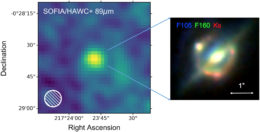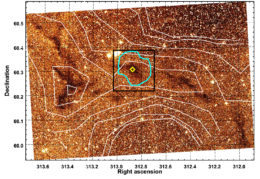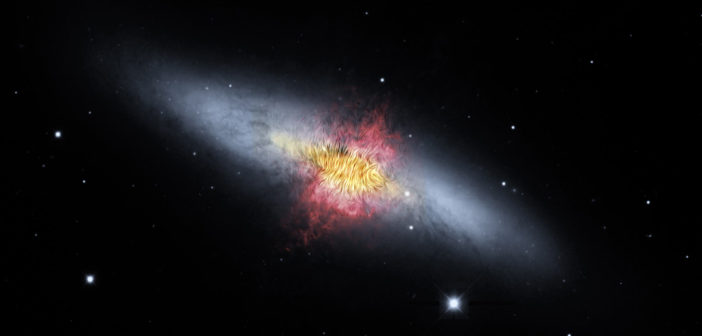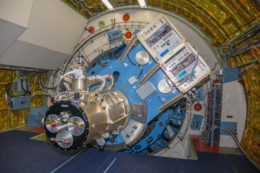In December, AAS Nova Editor Susanna Kohler had the opportunity to fly aboard the NASA/DLR Stratospheric Observatory for Infrared Astronomy (SOFIA). This week we’re taking a look at that flight, as well as some of the recent science the observatory produced and published in an ApJ Letters Focus Issue.
One of SOFIA’s great strengths is that the instruments mounted on this flying telescope can be easily swapped out, allowing for a broad range of infrared observations. Three of SOFIA’s instruments are featured in science recently published in the ApJ Letters Focus Issue: the Far Infrared Field-Imaging Line Spectrometer (FIFI-LS), the High-Resolution Airborne Wideband Camera Plus (HAWC+), and the Echelon-Cross-Echelle Spectrograph (EXES).
Meet HAWC+
HAWC+ is a one-of-a-kind instrument: it’s the only currently operating astronomical camera that takes images in far-infrared light. HAWC+ observes in the 50-μm to 240-μm range at high angular resolution, affording us a detailed look at low-temperature phenomena, like the early stages of star and planet formation.
In addition to the camera, HAWC+ also includes a polarimeter, which allows the instrument to measure the alignment of incoming light waves produced by dust emission. By observing this far-infrared polarization, HAWC+ can produce detailed maps of otherwise invisible celestial magnetic fields. The insight gained with HAWC+ spans an incredible range of astronomical sources, from nearby star-forming regions to the large-scale environments surrounding other galaxies.
Some Recent HAWC+ Science

Artist’s conception of Cygnus A, surrounded by the torus of dust and debris with jets launching from its center. Magnetic fields are illustrated trapping dust near the supermassive black hole at the galaxy’s core. [NASA/SOFIA/Lynette Cook]
In a recent study led by Enrique Lopez-Rodriguez (SOFIA Science Center; National Astronomical Observatory of Japan), a team of scientists has used HAWC+ to observe the polarized infrared emission from aligned dust grains in the dusty torus surrounding Cygnus A’s core. Lopez-Rodriguez and collaborators find that a coherent dusty and magnetic field structure dominates the infrared emission around the nucleus, suggesting that magnetic fields confine the torus and funnel the dust in to accrete onto the supermassive black hole.
••••••
Messier 82 and NGC 253 are two nearby starburst galaxies — galaxies with a high rate of star formation. Such galaxies often have strong outflowing galactic winds, which are thought to contribute to the enrichment of the intergalactic medium with both heavy elements and magnetic fields.
A study led by Terry Jay Jones (University of Minnesota) uses HAWC+ to map out the magnetic field geometry in the disk and central regions of these two galaxies. M82 shows the most spectacular results, revealing clear evidence for a massive polar outflow that drags the magnetic field vertically away from the disk along with entrained gas and dust.
••••••

SOFIA/HAWC+ 89 μm detection of the gravitationally lensed starburst galaxy J1429-0028. Right: false-color composite image of J1429-0028 from Hubble and Keck. [Ma et al. 2018]
••••••

The G 9 region, as represented by the Digital Palomar Observatory Sky Survey. The cyan polygon represents the SOFIA HAWC+ coverage of the filamentary dark cloud GF 9. The yellow diamond marks the YSO GF 9-2. [Clemens et al. 2018]
Surprisingly, the observations show a remarkably uniform magnetic field threading the entire region, from the outer, diffuse cloud edge all the way down to the smallest scales of the YSO surroundings. These results contradict some models of how cores and YSOs form, providing important information that will help us better understand this process.
Citation
ApJL Focus issue:
Focus on New Results from SOFIA
HAWC+ articles:
“The Highly Polarized Dusty Emission Core of Cygnus A,” Enrique Lopez-Rodriguez et al. 2018 ApJL 861 L23. doi:10.3847/2041-8213/aacff5
“SOFIA Far-infrared Imaging Polarimetry of M82 and NGC 253: Exploring the Supergalactic Wind,” Terry Jay Jones et al. 2019 ApJL 870 L9. doi:10.3847/2041-8213/aaf8b9
“SOFIA/HAWC+ Detection of a Gravitationally Lensed Starburst Galaxy at z = 1.03,” Jingzhe Ma et al. 2018 ApJ 864 60. doi:10.3847/1538-4357/aad4a0
“Magnetic Field Uniformity Across the GF 9-2 YSO, L1082C Dense Core, and GF 9 Filamentary Dark Cloud,” Dan P. Clemens et al. 2018 ApJ 867 79. doi:10.3847/1538-4357/aae2af


1 Comment
Pingback: Featured Image: SOFIA Traces a Galaxy’s Magnetic Field